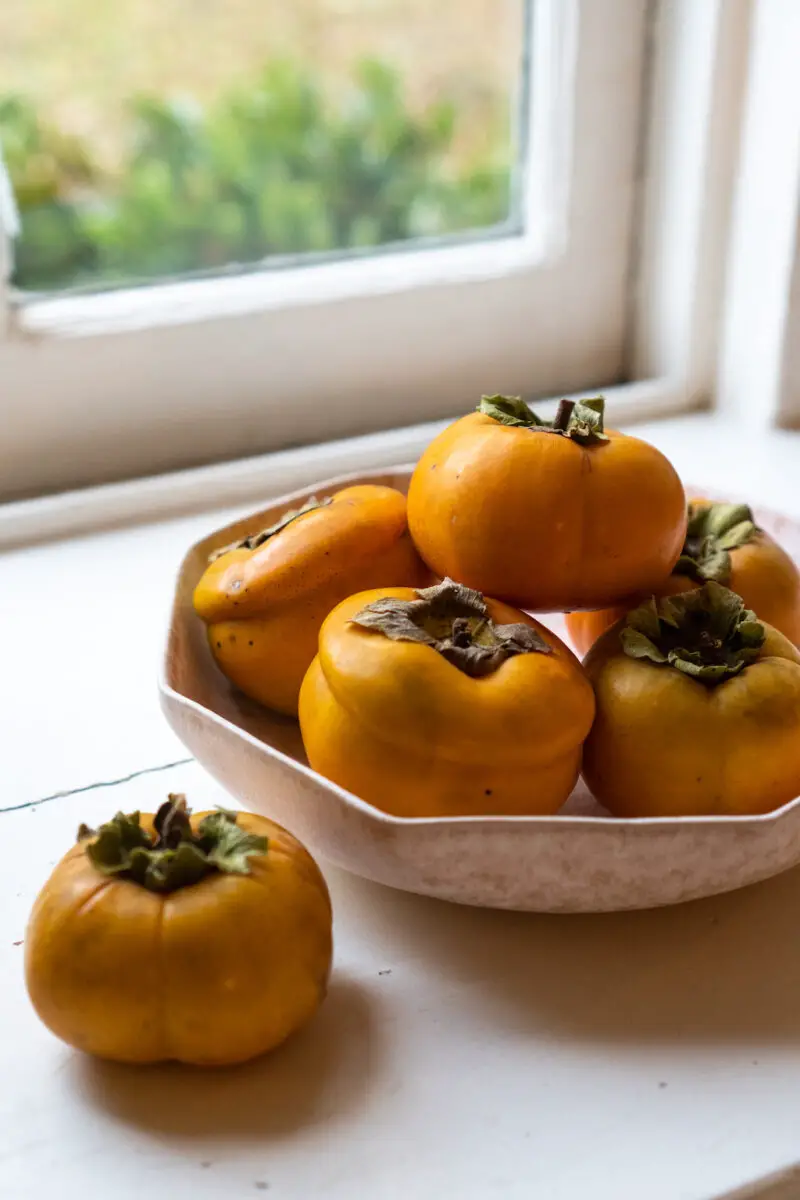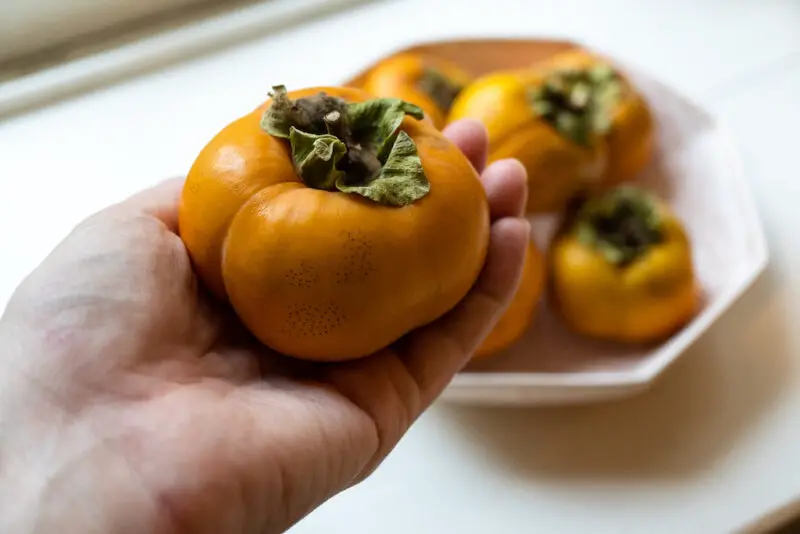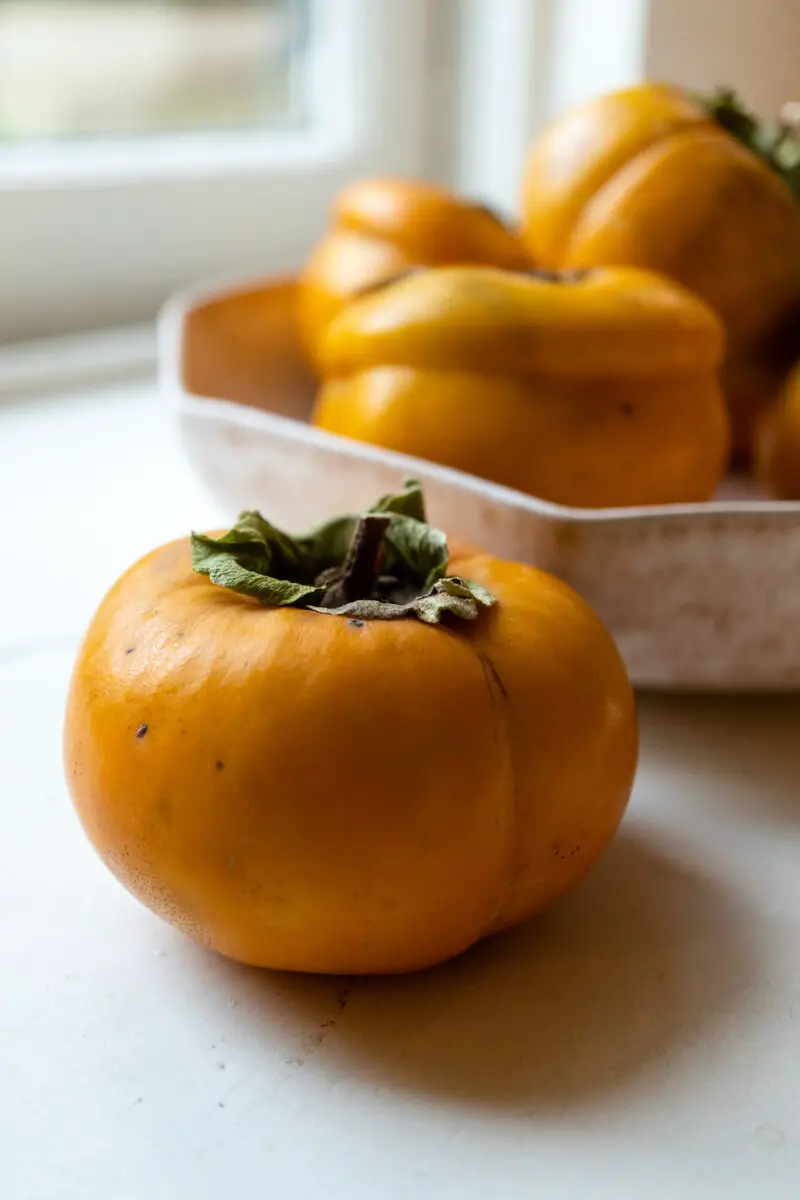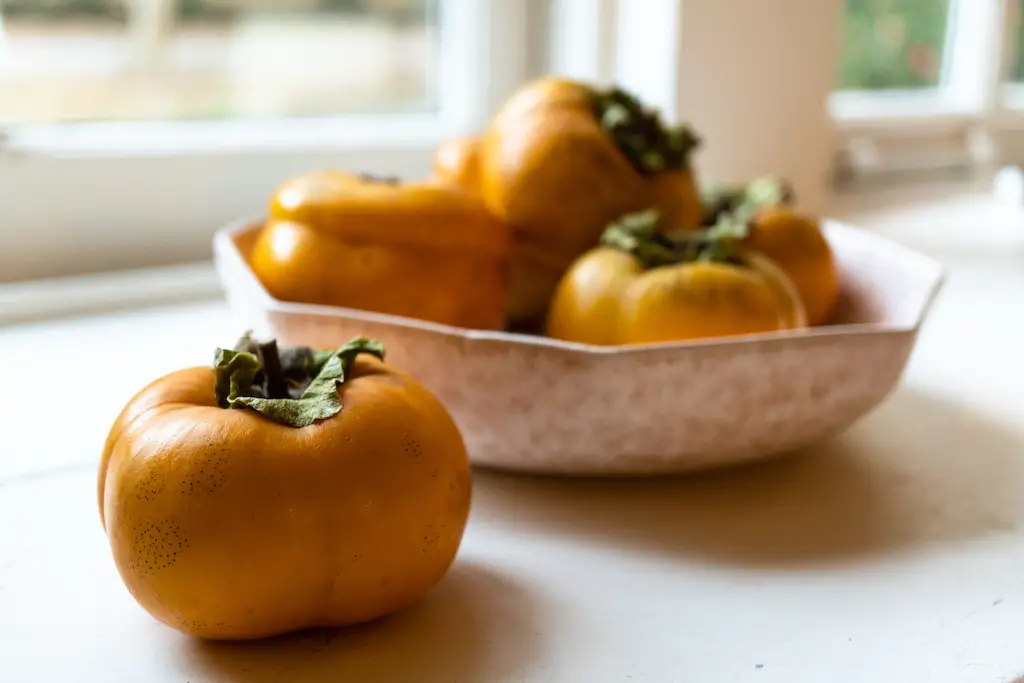This post may contain affiliate links. Please read my disclosure for details at the bottom of this page. As an Amazon Associate, I earn from qualifying purchases on this article about the persimmon fruit. Learn all about persimmons, otherwise known as gam, in Korean cuisine here!
Published 10/14/2021 Updated 01/04/2023
During the fall season, when you travel across South Korea, you will undoubtedly see rows of bright orange fruit hanging out to dry in the sun. These hanging fruits are persimmons, the edible fruit of numerous different species of trees in the genus of Diospyros.
Juicy and sweet, people in Korea love these fruits. Originally from China, persimmons made their way over to the Korean peninsula sometime in the last 1,000 years. Unfortunately, there are many contracting dates across the internet.
Like the Asian pear, I listed the persimmon in a previous post as one of the most commonly eaten fruits in South Korea. Here, we will list some important information about persimmons, their importance in Korean food culture, as well as how people in Korea eat the fruit.
Types of Persimmons:
Like I stated above, what we call ‘persimmons’ come from several different species of trees in the genus of Diospyros. As a result, these numerous types of persimmons have their unique flavor and appearance. Here, we will list the most common types of persimmons in South Korea.
When picking a persimmon, you first need to look at the type–you can either buy astringent or non-astringent varieties.

Astringent Persimmon Varieties:
What does it mean when we state that a persimmon fruit is ‘astringent?’ An astringent persimmon is a fruit with high tannin content. This tannin makes the unripe fruit extremely bitter. When consumed unripe, your mouth will pucker and you may experience dry-mouth and a numbing sensation. While non-astringent persimmons can be eaten fresh from the tree, the astringent varieties need to be picked and ripened until soft and mushy. When ripe, the fruit’s flesh becomes thick and jelly-like. Instead of bitter and sour, it will taste delightfully sweet.
The most famous types of astringent persimmons are of the Diopyros Kaki variety. The common term for these is oriental persimmons. The oriental persimmon is native to China and Northeast India. Otherwise known as the Chinese, Japanese, or Korean persimmon, you will find them grown in most East Asian countries. The fruits are sweet, tangy, and have a slightly spicy flavor.
The most famous variety of astringent persimmons is known as ‘Daebong-gam’ (대봉감) in Korean. In English, we refer to this variety as the ‘Hachiya persimmon.’
Another popular type of astringent persimmon in South Korea is ‘Hongsi’ (홍시).
Non-Astringent Persimmon Varieties:
Non-astringent persimmons do not contain the levels of tannin that cause the mouth-puckering sensation. Unlike the astringent varieties, you can eat these straight from the tree. Often, these varieties can have a crisp texture much like an apple. While the astringent varieties are extremely sweet, these are more mellow in flavor.
In South Korea, people often eat the non-astringent variety known as ‘dan-gam’ (단감). In English, we refer to these as ‘Fuyu’ persimmons.

Persimmons In Korean Culture:
In the Korean language, the generic term for these fruits is known as ‘감’ (gam), though the name changes based on the different varieties of persimmons from persimmon trees. Below, I list some interesting facts about persimmons in Korean culture:
- In South Korea, if you hear someone say the idiom ‘lying beneath a persimmon tree, waiting for a hongsi to drop into their mouth’ (감나무 밑에 누워서 홍시 입 안에 떨어지기를 기다린다), you are implying that someone is waiting for sweet rewards without putting in the any of the necessary work. Note: remember hongsi is a type of astringent persimmon.
- During the Joseon Dynasty when the Korean peninsula still had a king, the daebong fruit was rare and expensive. People from the Southern part of the peninsula would offer the fruits as a seasonal tribute to the king.
- In Korea, people traditionally used the wood of persimmon trees to make furniture and utensils. The wood is very expensive. Famously, around the world, people use persimmon wood to make expensive heads for golf clubs.
- It is traditional to leave a few persimmons on the tree after harvesting for the magpies. This is known as ggachi bap (까치 밥)–the magpie meal. The South Korean national bird is the magpie. It is beautiful to see people working and loving the nature of their country.
Dried Persimmons in Korean Culture:
- Most commonly people eat dried persimmons in South Korea. This is known as ‘got-gam’ (곶감). During fall, people harvest and then hang the fruit outside or in the window under direct sunlight. These fruits hang for weeks, often into the winter, but a white-looking ‘powder’ forms out the outside. This powder is the natural sugars from within the fruit. Once dried, the fruit becomes intensely sweet and jammy inside.
- The tradition of ‘got-gam’ goes back for hundreds of years. Traditional folklore and stories from long ago depict ‘got-gam’ often. Most famously, there is a traditional story called ‘The Tiger and the Dried Persimmon,’ which you can buy as a children’s book now. It tells the story of a tiger that fears a ‘got-gam’ after hearing a mother calm her crying baby with the dried fruit.
Learn more about this subject in my ingredient article about dried persimmons! This article goes more in-depth about dried persimmons in Korean cuisine.
So much more of Korean culture is rooted in persimmons. This very short list of facts only scratches the surface!
Examples of Persimmons in Korean Cuisine:
In South Korea, people tend to eat these juicy fruits either raw or dried. Like I stated above, the dried fruit is known as ‘got-gam’ (곶감).
While people in Korea usually eat persimmons raw or dried, you can find some instances of people using them to make foods and drinks. Below, we list two examples of when people cook with persimmons in Korea.
- Sujeonggwa (수정과): In English, this drink is known as Korean cinnamon punch. Often, you consume this drink around major holidays such as Chuseok. Often, people add dried persimmons as a garnish on top of the drink.
- Got-gam Hodu Mari (곶감호두말이): To make this recipe, you roll walnuts in dried persimmons. Then, you slice the roll to make individual bite-sized ‘cookies.’

Persimmon Frequently Asked Questions:
Below, I answer some questions you may have about persimmons. If I do not answer your question, feel free to leave your question in the comment section below or email me at [email protected].
When Are Persimmons Ripe?
While most fruits in the world need warm weather to fully ripen, the persimmon fruit ripens in the fall. The fall crop usually starts to ripen in September as the weather cools. You can then harvest the fruits throughout the autumn. Depending on your climate, you can sometimes continue to do so through the beginning of the following year during the cold winter months.
How Do You Know When Persimmons Are Ripe?
On one hand, non-astringent persimmon varieties can be eaten right off the tree when they are firm, crisp, and barely ripe. It is best to eat these when they are still firm and the flesh gives slightly when touched.
On the other hand, you need to wait for astringent persimmons to be fully ripe before eating. An astringent persimmon needs to ripen until soft and almost mushy to touch.
How Do You Store the Persimmon Fruits?
Permissions should be kept at room temperature until very ripe. Once ripe, you can store them in the fridge in an airtight container.
I Hope You Enjoyed Learning About the Persimmon Fruit!
In the end, we hope you enjoyed learning about ‘gam,’ otherwise known as a persimmon fruit. If so, let me know in the comment section below. I will continue to write about different ingredients used in Korean and Southern cooking!
If you would like to read more about cooking, you can find recipes on my blog. I listed some of my favorite Carving A Journey Korean recipes below! For reference, many recipes are influenced by our blended Korean and Southern heritage.
Korean Ingredient Articles:
- Dangmyeon (Sweet Potato Glass Noodles)
- Gochugaru (Korean Pepper Powder)
- Korean Soy Sauce: What Should I Buy?
- Gluten-Free Gochujang Brands; And
- Gluten-free Doenjang Brands
Further Carving A Journey Korean Recipes:
- Korean Sweet Potato Latte (Goguma Latte)
- Greek Momo Recipe (Korean Breakfast Trend)
- Tteokkochi (Korean Rice Cake Skewers); And
- Korean Rice Paper Tteokbokki
If you have any questions or comments, you can also email me at [email protected].
And, finally, I would love to hear from you through our social media as well! You can follow me at @carvingajourney on Instagram, Twitter, Facebook, and Pinterest. I also started a vlog Youtube channel with my husband! Or, if you would like more articles like these, you can subscribe to the blog by joining the mailing list. Let me know if you try using persimmons while cooking! Thank you so much for stopping by!
Carving A Journey is a participant in the Amazon Services LLC Associates Program, an affiliate advertising program designed to provide a means for sites to earn advertising fees by advertising and linking to Amazon.com. Although we may earn commissions for our endorsement, recommendation, testimonial, and/or link to any products or services from this website, these opinions are my own and I fully support these products.

